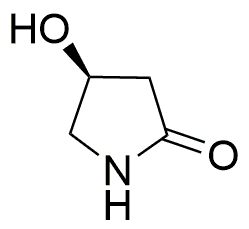(S)-(-)-4-Hydroxy-2-pyrrolidinone is widely utilized in research focused on
- Pharmaceutical Development: This compound serves as an important intermediate in the synthesis of various pharmaceuticals, particularly in the development of drugs targeting central nervous system disorders.
- Chiral Catalysis: It is used as a chiral ligand in asymmetric synthesis, providing researchers with a means to produce enantiomerically pure compounds, which are crucial in drug formulation.
- Biochemical Research: The compound is employed in studies related to neurotransmitter modulation, helping scientists understand its effects on brain chemistry and potential therapeutic applications.
- Polymer Chemistry: It can be used to create biocompatible polymers, making it valuable in the development of drug delivery systems and medical devices.
- Cosmetic Formulations: Due to its hydrophilic properties, it is incorporated into skincare products to enhance moisture retention and improve skin texture.
General Information
Properties
Safety and Regulations
Applications
(S)-(-)-4-Hydroxy-2-pyrrolidinone is widely utilized in research focused on
- Pharmaceutical Development: This compound serves as an important intermediate in the synthesis of various pharmaceuticals, particularly in the development of drugs targeting central nervous system disorders.
- Chiral Catalysis: It is used as a chiral ligand in asymmetric synthesis, providing researchers with a means to produce enantiomerically pure compounds, which are crucial in drug formulation.
- Biochemical Research: The compound is employed in studies related to neurotransmitter modulation, helping scientists understand its effects on brain chemistry and potential therapeutic applications.
- Polymer Chemistry: It can be used to create biocompatible polymers, making it valuable in the development of drug delivery systems and medical devices.
- Cosmetic Formulations: Due to its hydrophilic properties, it is incorporated into skincare products to enhance moisture retention and improve skin texture.
Documents
Safety Data Sheets (SDS)
The SDS provides comprehensive safety information on handling, storage, and disposal of the product.
Product Specification (PS)
The PS provides a comprehensive breakdown of the product’s properties, including chemical composition, physical state, purity, and storage requirements. It also details acceptable quality ranges and the product's intended applications.
Certificates of Analysis (COA)
Search for Certificates of Analysis (COA) by entering the products Lot Number. Lot and Batch Numbers can be found on a product’s label following the words ‘Lot’ or ‘Batch’.
*Catalog Number
*Lot Number
Certificates Of Origin (COO)
This COO confirms the country where the product was manufactured, and also details the materials and components used in it and whether it is derived from natural, synthetic, or other specific sources. This certificate may be required for customs, trade, and regulatory compliance.
*Catalog Number
*Lot Number
Safety Data Sheets (SDS)
The SDS provides comprehensive safety information on handling, storage, and disposal of the product.
DownloadProduct Specification (PS)
The PS provides a comprehensive breakdown of the product’s properties, including chemical composition, physical state, purity, and storage requirements. It also details acceptable quality ranges and the product's intended applications.
DownloadCertificates of Analysis (COA)
Search for Certificates of Analysis (COA) by entering the products Lot Number. Lot and Batch Numbers can be found on a product’s label following the words ‘Lot’ or ‘Batch’.
*Catalog Number
*Lot Number
Certificates Of Origin (COO)
This COO confirms the country where the product was manufactured, and also details the materials and components used in it and whether it is derived from natural, synthetic, or other specific sources. This certificate may be required for customs, trade, and regulatory compliance.


